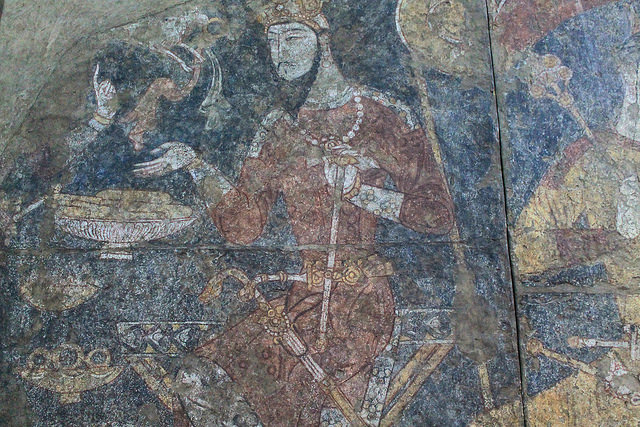Sogdians were an ancient Iranian people whose homeland Sogdia was in Transoxiana. They established the two great cities of Bukhara and Samarkand. They were a part of the larger Persian world where their unique culture which was influenced not only by Zoroastrianism but also Buddhism, Manichaeism, Nestorian and Syriac Christianity and even Mesopotamian and Indian faiths. Sogdian culture survived into the eighth century CE declining first after the Arab Islamic conquests around the same time and then finally by the mass expansion of Turkic peoples into the region in the eleventh century.
As interesting as these Sogdians were, even more interesting were their immigrant communities in the Tarim Basin and China proper. They established themselves as one of the dominant immigrant populations and were famous for their work in commerce particularly along the Silk Road. Archaeological discoveries over the last century have established the extent of their presence in what was a little-known part of the regional history.
Archaeologist Aurel Stein’s discovery of the Sogdian letters mentioned their presence in Luoyang, Chang’an (Xian), Lanzhou, Wuwei, Jiuquan and Dunhuang where they were involved in trading linen, woolen cloth, musk, cosmetics, pepper, camphor and silk demonstrating the extent of their trade networks into Central Asia, China and India and perhaps even Southeast Asia.
Probably the largest concentration of Sogdians was in Chang’an the capital of the Tang dynasty which held numerous immigrant communities including Turks, Persians and most likely Mesopotamian peoples. A single church from the Church of the East and several Zoroastrian temples existed among Buddhist temples. Even the descendants of the last Sasanian Emperor Yazdegerd III made Chang’an home after the fall of Ctesiphon to the Muslim forces.
Sogdian’s were strongly associated with being involved in commercial trade which became a theme adopted in some of the Chinese “wonder tales” which peaked in popularity during the mid-ninth century. Sogdians were stereotyped as being very generous with a penchant to assess the value of jewels but forced to menial jobs due their immigrant status not unlike immigrants today. While there were some wealthy traders most Sogdians worked as farmers, metalsmiths, soldiers and emissaries.
Unfortunately, fate was about to turn on the Sogdians and other immigrants in China. It started with the An Lushan Rebellion. An Lushan’s paternity has been a debate among historians as An is a Sogdian name. Whether or not he had Sogdian ancestry or adopted a Sogdian name the anti-immigrant sentiment took hold particularly targeted against the Sogdians. The ethnically Korean Tang general who cleared Beijing of the rebels offered reward for those who killed Hu, which were Iranians or Sogdians, and the Jiehu sub-group were decimated. Small children were thrown into the air and speared on lances while even non-Sogdians who had large Indo-European noses were killed.
Economic troubles followed the An Loushan Rebellion caused by Tibetan and Uighur expansion. Foreign envoys were no longer supported or welcome. Finally, in 843, pandering to nationalist sentiments, the Emperor banned Manichaeism and two years later he banned Buddhism, Zoroastrianism and Christianity, though the ban on Buddhism would be lifted four years later explaining the survival of it and death of the other faiths in China. Although the climate of hate and discrimination did not remain, the disruption of land routes now controlled by fragmented states and the rise of the sea route to India did not make an enabling environment for those Sogdian communities to be revived.
The Sogdian story is so interesting because it shows the long history the Indo-European peoples had in Central Asia and into China. Even more interesting is the parallels between the Sogdian immigrants and those of today where nationalist movements only result in discrimination, abuse, persecution and ultimately violence and death. Though their case is particularly fascinating as they were Indo-European immigrants to China in East Asia. For those interested in the Sogdians I highly recommend Valerie Hansen’s excellent The Silk Road: A New History.
The photo is a scene from a Sogdian palace and is courtesy of Flickr user Robert Wilson and subject to use under the conditions of the Creative Commons.

